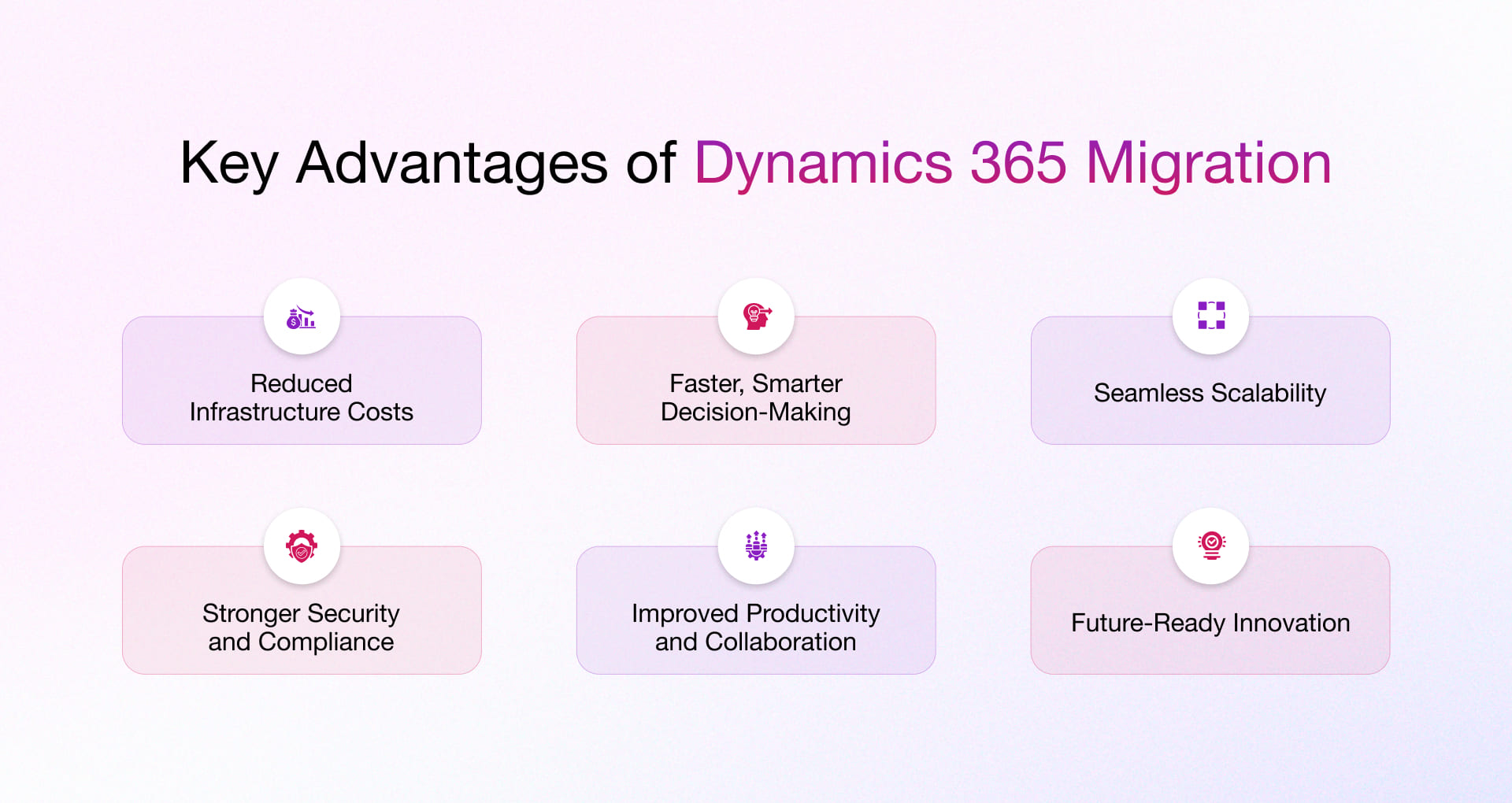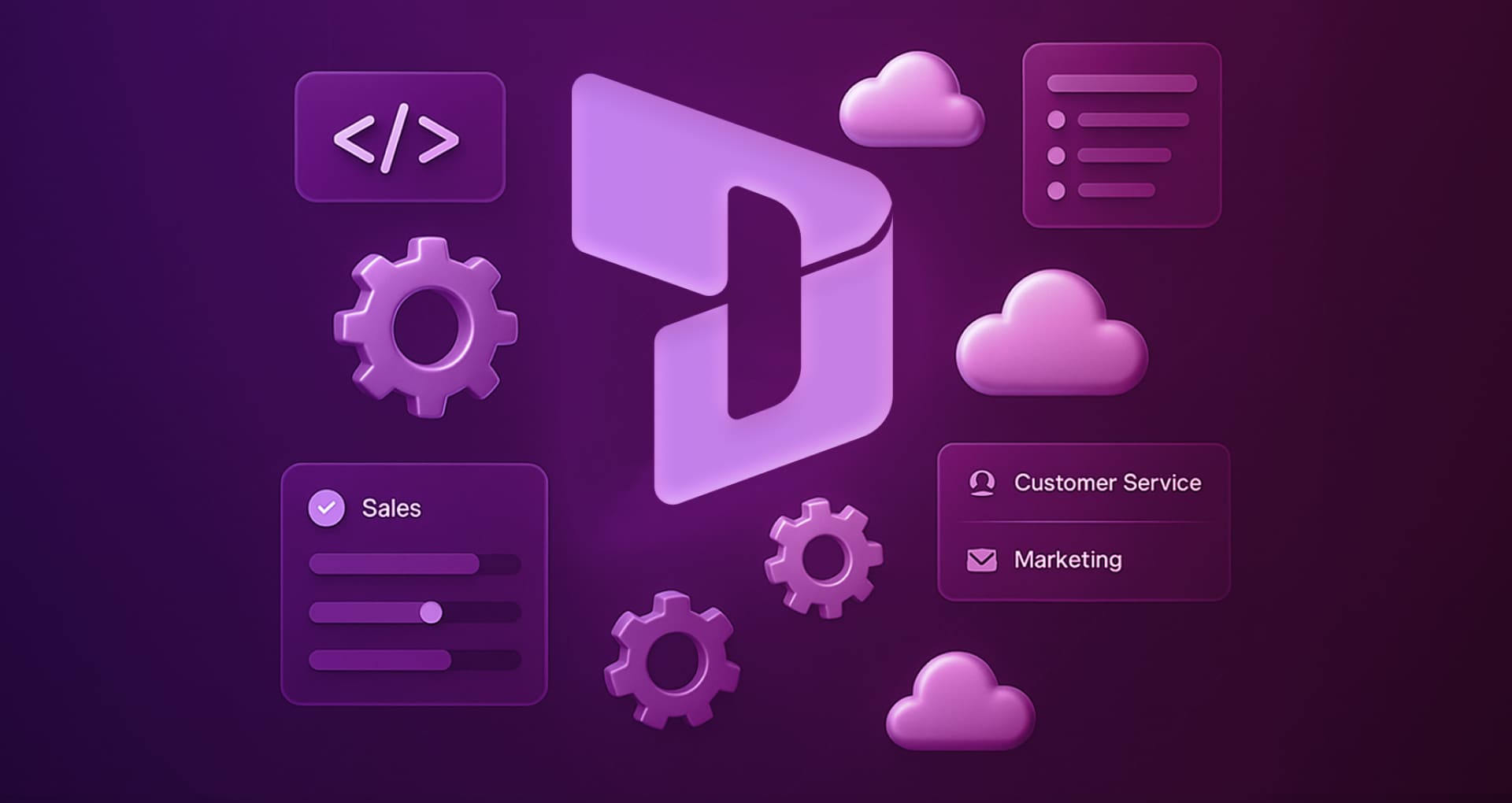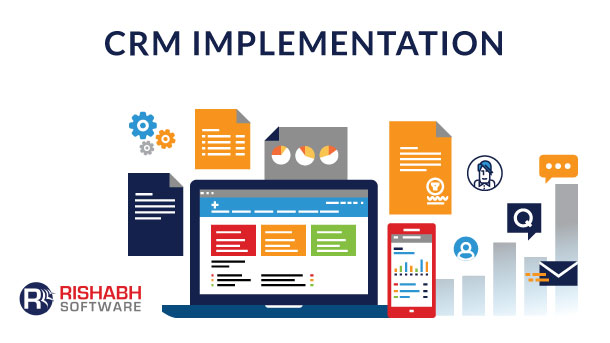The biggest risk for enterprises today isn’t failing to innovate. It’s moving too slowly. Businesses that delay Microsoft Dynamics 365 migration often find themselves outpaced by competitors who are scaling faster, cutting costs smarter, and delivering better customer experiences.
As a CTO or CEO, you’re likely balancing questions that go beyond IT:
- How do we successfully migrate without disrupting ongoing operations?
- Will the investment in migration translate into faster ROI?
- What risks, such as data loss, compliance gaps, or performance issues, should we anticipate and mitigate?
- How do we ensure our teams adapt quickly without productivity dips?
These challenges often delay modernization, but postponing comes at its own cost. It leads to higher infrastructure spend, inefficiencies, and limited scalability. The reality is clear: staying on outdated systems creates more risk than migrating. The real question isn’t if you should move, but how to do it strategically so your business gains speed, security, and resilience.
Business Benefits of Migrating to Dynamics 365
Migrating to Dynamics 365 is not just about modernizing software. It’s about creating a business engine that is agile, cost-efficient, and ready for scale. A Forrester Consulting study commissioned by Microsoft shows the real impact of Dynamics 365. Companies that adopted it achieved a 215% ROI within three years and achieved $48.34 million in net present value. This isn’t about adding another CRM to your stack. It’s about transforming sales into a profit engine that empowers teams, accelerates deals, and delivers measurable business growth.

- Reduced Infrastructure Costs
Legacy on-premise systems lock enterprises into high maintenance spend and unpredictable overhead. With a Dynamics 365 cloud migration, you eliminate these fixed costs and move to a pay-as-you-go model. This means predictable budgets, lower CapEx, and the freedom to reinvest savings into innovation.
- Faster, Smarter Decision-Making
With Microsoft Dynamics 365 migration services, enterprises gain real-time insights by unifying data across finance, operations, and customer functions. This helps leadership teams act quickly, cut inefficiencies, and drive faster ROI on digital initiatives.
- Seamless Scalability
Scaling on legacy systems often means long IT cycles and resource-heavy upgrades. Dynamics 365 on-premise to cloud migration allows you to scale instantly, whether that’s adding users, integrating apps, or handling seasonal spikes, without disruptions.
- Stronger Security and Compliance
Staying on outdated systems comes with mounting risks such as data loss, compliance failures, and vulnerability to breaches. Microsoft Dynamics 365 migration ensures enterprise-grade security, continuous updates, and built-in compliance with global regulations, giving CTOs and CEOs peace of mind.
- Improved Productivity and Collaboration
Cloud-driven tools like Teams, Power BI, and Office 365 integrate seamlessly with Dynamics 365, enabling faster collaboration across geographies. The result is higher team productivity and quicker adoption, without the long learning curve typical of legacy ERP upgrades.
As per the Forrester Total Economic Impact™ Study Commissioned By Microsoft, June 2024, A mid-sized composite organization migrating to Dynamics 365 Business Central saw up to 18% productivity gains in finance and operations, alongside substantial reduction in third-party and legacy system costs.
- Future-Ready Innovation
By embracing Dynamics 365 cloud migration, enterprises unlock AI, automation, and advanced analytics. This is not just a tech upgrade. It is the foundation for future-proofing your business against market shifts and competitive pressures.
Successful Dynamics 365 Data Migration: A Step-by-Step Roadmap
Migrating to Microsoft Dynamics 365 isn’t just about moving data from one system to another. It’s about ensuring that every customer record, sales pipeline, financial entry, and operational workflow makes the shift intact, without disrupting business continuity. To get this right, you need more than tools. You need a structured roadmap that guides you through planning, execution, and post-migration optimization.

Here’s a detailed step-by-step roadmap every enterprise should follow:
1. Define Migration Goals and Business Scope
Before touching data or tools, define why you’re migrating and what success looks like.
Key actions to take:
- Identify business goals: Is migration driven by cost savings, scalability, compliance, or a need for better customer experience? Write this down because it will guide your decisions later.
- Prioritize modules: Dynamics 365 has multiple workloads (Sales, Finance, Customer Service, HR). Decide which modules you’ll migrate first. A phased approach is safer than a significant bang migration.
- Document success metrics: For example, “Reduce system downtime to less than 2 hours” or “Achieve 100% data accuracy on customer accounts.” These benchmarks will help measure post-migration success.
Why it matters: Without defined objectives, migrations drift, costs overrun, and timelines extend.
2. Audit and Cleanse Existing Data
Take stock of your existing systems, data, and integrations. You need to know what you’re migrating and what you can safely leave behind.
Key actions to take:
- Audit your data: Identify the volume, types (structured/unstructured), and sources of data. For example, are customer emails stored in Outlook, CRM, or both?
- Check dependencies: Many legacy CRMs are tied into finance, ERP, or custom-built tools. Map these integrations before migration.
- Evaluate infrastructure: If you’re moving from an on-premises CRM to the cloud, ensure your network bandwidth, security policies, and storage capacity align with Dynamics 365.
Why it matters: A proper assessment prevents “surprise workloads” and ensures your migration scope is realistic.
3. Design the Data Mapping Strategy
Bad data in = bad data out. This step ensures only clean, relevant, and usable data moves into Dynamics 365.
Key actions to take:
- De-duplicate records: Remove duplicate customer profiles and transaction entries.
- Validate data quality: Fix formatting issues (e.g., inconsistent date formats or incorrect phone numbers).
- Archive outdated data: Don’t migrate old or irrelevant records unless needed for compliance.
- Map data fields: Align your existing data fields with the Dynamics 365 schema. For example, “Customer_ID” in your legacy system should map correctly to “Account_ID” in Dynamics 365.
Why it matters: Clean data ensures your users trust the new system from Day 1 — no clutter, no errors.
4. Choose the Right Migration Tools and Methods
How you migrate is just as important as what you migrate. Since Dynamics 365 migration is part of the broader cloud journey, Microsoft recommends different cloud migration strategies depending on complexity and downtime tolerance.
Key actions to take:
- Lift-and-shift (rehost): Move data with minimal changes. Best for quick migrations but not ideal for long-term scalability.
- Replatforming: Make minor adjustments for compatibility while moving. This balances speed and optimization.
- Refactoring: Redesign workflows or processes for Dynamics 365-native functionality. Best if you want full value from the platform.
Microsoft provides official tools to make migration smoother. Use them instead of building everything from scratch.
Key Tools to Use:
- Dynamics 365 Data Migration Assistant: Identifies compatibility issues before migration.
- Configuration Migration Tool: Helps move configurations like workflows and templates.
- Data Export Service / Data Import Wizard: For moving large datasets with accuracy.
- Lifecycle Services (LCS): For Finance & Operations workloads.
Why it matters: Choosing the wrong strategy or tool can result in high costs, broken integrations, or downtime.
5. Test in a Sandbox Environment
Never migrate directly to production. Always test first.
Key Tools to Use:
- Set up a sandbox: Replicate your real-world environment with test data.
- Run trial migrations: Move sample datasets and validate mapping.
- Perform user acceptance testing (UAT): Involve business users to check if migrated data and workflows meet business needs.
- Stress test integrations: Validate performance under load, especially for customer-facing apps.
Why it matters: Testing catches errors before they affect your business.
6. Execute Full Migration with Minimal Downtime
What it means: Move data and configurations into production following a planned cutover strategy.
Key actions to take:
- Schedule downtime: Communicate the migration window to all users.
- Execute in waves: Migrate business-critical modules first, then expand.
- Monitor in real-time: Track progress, error logs, and performance metrics.
- Have rollback plans: Be ready to revert if something breaks.
Why it matters: A controlled execution reduces risk and ensures business continuity.
7. Post-Migration Validation
Migration doesn’t end when the data is moved. You need to validate and optimize.
Key actions to take:
- Verify data accuracy: Check record counts, formats, and relationships.
- Validate integrations: Ensure all third-party systems work as expected.
- Get business user sign-off: Confirm that users can perform their daily tasks without disruption.
- Optimize performance: Fine-tune workflows, reports, and dashboards.
Why it matters: Validation ensures your Dynamics 365 system is reliable, usable, and ready for scale.
8. Train and Support End-Users
A successful migration is useless if your team doesn’t adopt Dynamics 365.
Key actions to take:
- Provide role-based training: Sales, finance, and customer service teams each need tailored sessions.
- Offer quick reference guides: Cheat sheets, FAQs, or short video tutorials help speed adoption.
- Set up ongoing support: Establish a helpdesk or center of excellence for user queries.
- Gather feedback: Use surveys or workshops to capture user challenges and improve processes.
Why it matters: Adoption drives ROI. Without it, your migration is just a technical exercise.
Importance of Post-Migration Validation and Monitoring
Your Dynamics 365 migration doesn’t end once the data is moved. The real test begins after go-live, when users, processes, and systems start running in the new environment. Without rigorous validation and monitoring, even a successful migration can lead to hidden errors, data mismatches, or performance bottlenecks that directly impact business operations.
Why validation matters:
- Data accuracy: Confirm that all records, relationships, and fields migrated correctly. Even small gaps can distort reporting and compliance.
- Process integrity: Validate that business workflows, automations, and custom apps work exactly as they did (or better) in Dynamics 365.
- User adoption: Ensure employees experience a smooth transition, with no broken links or missing data slowing down productivity.
Why monitoring is critical:
- Performance tracking: Proactively detect latency issues, slow queries, or integration failures before they disrupt daily operations.
- Error detection: Identify anomalies in data pipelines or API calls early to prevent larger business impacts.
- Continuous improvement: Leverage monitoring insights to fine-tune configurations, security settings, and storage usage.
Best practices for enterprises:
- Run parallel testing for critical business processes before decommissioning legacy systems.
- Use built-in Dynamics 365 telemetry tools and Azure Monitor for real-time visibility.
- Establish a feedback loop with end-users to capture and resolve issues quickly.
Post-migration validation and monitoring are not optional checkpoints. They are ongoing disciplines that ensure your Dynamics 365 environment delivers the performance, security, and reliability your enterprise expects.
Key Challenges in Dynamics 365 Migration and How to Overcome Them
Migrating to Dynamics 365 is a big leap forward, but it isn’t without roadblocks. The good news? With the right approach, each challenge has a clear solution.
1. Data Complexity and Integrity
Challenge: Enterprises often struggle with messy, duplicate, or incomplete data. When this is moved “as is,” it can corrupt reports, slow down processes, and reduce adoption.
Solution: Invest in data profiling and cleansing before migration. Use Microsoft’s Data Import Wizard for simple needs, or Azure Data Factory and third-party ETL tools for complex datasets. Define mapping rules upfront to ensure accuracy, and always run test loads to validate before the final move.
2. Downtime and Business Disruption
Challenge: Migration can disrupt day-to-day operations if not planned carefully. A single missed dependency can result in extended downtime.
Solution: Minimize impact by adopting a phased migration strategy. Use sandbox environments to rehearse cutovers, and plan final migration during low-activity hours. Microsoft’s Migration Program also provides structured guidance to reduce downtime.
3. Integration with Legacy Systems
Challenge: Many enterprises run Dynamics 365 alongside ERP, HRMS, or third-party apps. Broken integrations during migration can halt critical workflows.
Solution: Conduct a dependency analysis early. Use Power Platform connectors, APIs, or middleware (like KingswaySoft or Scribe) to rebuild integrations. Test them extensively in pre-production before go-live to avoid broken workflows.
4. User Adoption and Change Resistance
Challenge: Even the most technically perfect migration fails if employees don’t adopt the new system. Resistance usually stems from lack of training or fear of change.
Solution: Prioritize user onboarding and training. Offer role-based demos, quick reference guides, and ongoing support post-migration. Encourage adoption by showing how Dynamics 365 simplifies daily tasks rather than adding complexity.
5. Security and Compliance Risks
Challenge: Data migration opens temporary vulnerabilities. Enterprises in regulated industries risk non-compliance if sensitive data is mishandled.
Solution: Implement role-based access controls during migration. Use Microsoft’s Data Loss Prevention (DLP) policies and encryption standards. Conduct a compliance audit post-migration to ensure industry standards like GDPR or HIPAA remain intact.
Why Choose Us for Microsoft Dynamics 365 Migration Services?
At Rishabh Software, our Dynamics 365 Consulting Services are designed to help businesses transition with confidence. We go beyond simple data transfer to ensure your business gets the maximum value from its CRM investment.
Here’s how we deliver impact:
- Comprehensive Migration Expertise
From legacy CRM to Dynamics 365, we handle assessment, planning, data mapping, customization, and deployment with proven frameworks that minimize risk. - Tailored Business-Centric Solutions
Every migration strategy is customized to your industry and workflows so Dynamics 365 aligns seamlessly with your operations. - Seamless, Low-Disruption Execution
We use best-in-class tools and accelerators to ensure minimal downtime while keeping your data secure and compliant. - Future-Ready Enhancements
Beyond migration, our team supports you with complete Dynamics 365 implementation to ensure a smooth transition tailored to your business needs. We also specialize in Dynamics 365 integration, enabling your apps, data, and workflows to work seamlessly together. From custom development to intelligent automation, we help you unlock the full potential of Dynamics 365 and scale with confidence.
With Rishabh Software, you gain more than a migration partner. You gain a trusted advisor who ensures Dynamics 365 works as a growth engine, driving better customer engagement, smarter decision-making, and measurable ROI.
Frequently Asked Questions
Q. What are the best practices for a smooth Dynamics 365 migration?
A. Successful migration depends on planning and execution. Start by defining a clear migration roadmap with timelines, ownership, and risk mitigation. Clean and standardize your data before moving it to avoid errors downstream. Choose the right migration tool set based on complexity, from the built-in Data Import Wizard to Azure Data Factory or Microsoft’s Migration Program. Always run a pilot migration to identify gaps before going live. Finally, after migration, validate data accuracy, monitor performance, and invest in user training to ensure adoption and ROI.
Q. How long does Dynamics 365 migration take?
A. The timeline depends on data volume, complexity, and integrations, but most projects take anywhere from a few weeks to a few months.
Q. What data can be migrated to Dynamics 365?
A. You can migrate master data (customers, vendors, products), transactional data (sales orders, invoices), historical records, and even custom entities, depending on your business needs.
Q. Can I migrate from on-prem Dynamics (AX, GP, NAV, CRM) directly to Dynamics 365?
A. Yes, Microsoft provides migration tools and upgrade paths to move from on-premise versions of AX, GP, NAV, or CRM to Dynamics 365, though the process may require data mapping, cleansing, and reconfiguration.











 30 Min
30 Min


